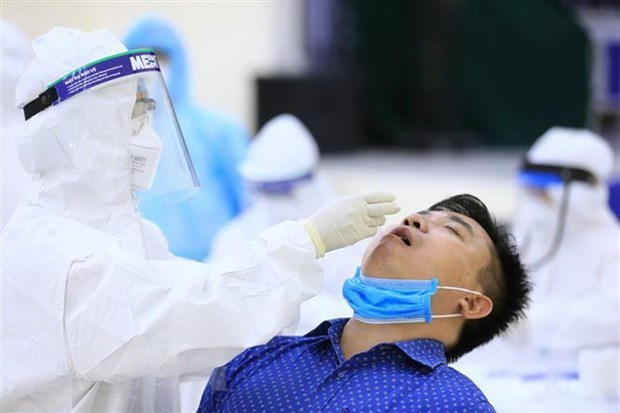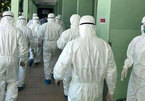 |
|
Illustrative image |
Doctor Dong Phu Khiem, deputy head of the resuscitation department at the National Hospital of Tropical Diseases in Hanoi, recounted his days struggling to help COVID-19 patients.
Saving the lives of patients
According to Khiem, in the early days of March, when the COVID-19 pandemic broke out in Vietnam, specialised ambulances continuously worked to carry patients to the hospital.
When the 17th patient was hospitalised on March 5 and tested positive for SARS-CoV-2 the next day, many people became worried. Before that, the country had recorded no new infections for more than 20 straight days.
On March 7, another patient was transferred to the hospital. The testing result showed that the patient was positive for the virus.
By March 12, the total number of COVID-19 cases treated at the hospital amounted to 10, including six foreigners.
In only a few days, all medical workers at the hospital were mobilised. Patients infected with the disease were treated in a separate area. Suspected cases (F1) were closely monitored and quarantined. During the peak of the disease, the 500-bed hospital had to treat nearly 400 patients and monitor other suspected cases.
Doctor Nguyen Trung Cap, head of the hospital’s Emergency Department, said the number of critically ill patients increased in the second and third waves of the disease. Health workers had to work hard day and night to minimise the fatalities.
Doctor Nguyen Trung Cap, head of the hospital’s Emergency Department (Photo: Minh Quyet/Vietnam News Agency).
Statistics showed that the hospital received and treated 143 patients who tested positive for SARS-CoV-2 (over 50 percent of the total cases in Vietnam), including 15 critically ill patients and five who had to use ventilators and intensive treatment around the clock.
With the help of the entire medical staff, the hospital has successfully treated 109 patients. At present, only two patients need ventilators, but their health continues to improve.
The hospital also received over 2,100 suspected cases for quarantine, including 30 from Wuhan in China – the epicentre of the disease. To date, more than 100 cases are continuously quarantined and undergo health monitoring. The remainders have been discharged from the hospital.
Recovered patients at the National Hospital of Tropical Diseases (Photo: VietnamPlus)
Ensuring fighting strength
Doctor Nguyen Trung Cap recounted that, during the peak of the disease, his department had seven doctors and 15 nurses treating 15 COVID-19 patients.
“We sometimes have the feeling that we cannot distinguish what the date is today due to the heavy workload. We have no concept of days off and working days,” he said.
Recounting a series of treatment days for patients, Cap said that most of the patients were Vietnamese in the first phase, but in the second phase, the hospital received patients from different countries, such as the UK, France, Germany and Sweden. The quick spread of the disease and the treatment of patients from different countries caused a lot of difficulties for health workers, like language barriers.
Treating a critically ill patient at the National Hospital of Tropical Diseases (Photo: VietnamPlus).
Cap said hospitals are on the frontline of the battle against COVID-19. Despite the complicated developments of the disease, no one has stopped in this fight, he added.
The risk of transmission among health workers is the biggest threat to all hospitals, Cap said, adding that, ensuring fighting sources is important to win the fight. Therefore, the hospital had opened training courses for its medical staff before the disease outbreak and prepared the best protective equipment to minimise the transmission risk.
Thank you Vietnam!
Thanks to the efforts of soldiers in white coats nationwide, Vietnam has achieved unexpected achievements. The world has recorded over 3.4 million infections and over 239,000 deaths, and Vietnam shares a long borderline with China – where the pandemic first occurred, the Southeast Asian country has promptly localised outbreak areas and treated successfully 223 out of the total 270 patients, with zero death.
Dixong John Garth and his wife are treated at the National Hospital of Tropical Diseases (Photo: VietnamPlus)
Among the recovered patients, many are foreign nationals who expressed their admiration for Vietnam’s health care system. Shan Coralie Baker (67 years old) and her husband Dixong John Garth (74 years old) from the UK shared that 22:00 on April 13 was a memorable moment for them because they were discharged from the hospital and returned to their hometown safely after 35 days of treatment.
Earlier in March 2020, Shan Coralie Baker and her spouse came to Vietnam to visit their son in the central city of Da Nang. They tested positive for SAR-CoV-2 and brought to the National Hospital of Tropical Diseases.
Baker said she was shocked at first. Her health status became more serious as she began to cough a lot and struggled to breath. She thought she would die. But Vietnamese doctors have saved her life.
After active treatment, she had gradually recovered and tested negative for the virus three times. But her husband had to use a ventilator.
Shan Coralie Baker and her husband are given the all-clear from the disease and allowed to discharge from the hospital (Photo: VietnamPlus).
Baker said that, when she knew that her husband was transferred to the resuscitation department, she was very scared. With nursing experience in the UK for 40 years, she understood that this is a very critical condition that could be life-threatening.
However, the medical staff at the hospital had worked for 10 days to save the life of her husband – a 10-year blood cancer patient, she said.
She expressed her deep gratitude and admiration for Vietnamese health workers. She said they were very lucky to meet Vietnamese doctors and nurses. “Thank you! Thank you so much!” VNA

Brave doctors head to Da Nang to fight outbreak
As thousands of tourists fled Da Nang after the COVID-19 outbreak sprang up in the central city, dozens of leading doctors went in the opposite direction, towards the danger.